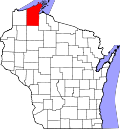Bayfield County | |
|---|---|
 | |
 Location within the U.S. state of Wisconsin | |
 Wisconsin's location within the U.S. | |
| Coordinates: 46°38′N91°11′W / 46.63°N 91.18°W | |
| Country | |
| State | |
| Founded | 1845 |
| Named after | Henry Bayfield |
| Seat | Washburn |
| Largest city | Washburn |
| Area | |
• Total | 2,042 sq mi (5,290 km2) |
| • Land | 1,478 sq mi (3,830 km2) |
| • Water | 564 sq mi (1,460 km2) 28% |
| Population (2020) | |
• Total | 16,220 |
• Estimate (2024) | 16,838 |
| • Density | 10.97/sq mi (4.237/km2) |
| Time zone | UTC−6 (Central) |
| • Summer (DST) | UTC−5 (CDT) |
| Congressional district | 7th |
| Website | www |
Bayfield County is a county located in the U.S. state of Wisconsin. As of the 2020 census, its population is 16,220. [1] Its county seat is Washburn. [2] The county was created in 1845 and organized in 1850. [3] The Red Cliff Band of Lake Superior Chippewa has a reservation in Bayfield County and is the county's largest employer. [4] The county is considered a high-recreation retirement destination by the U.S. Department of Agriculture. [5]


